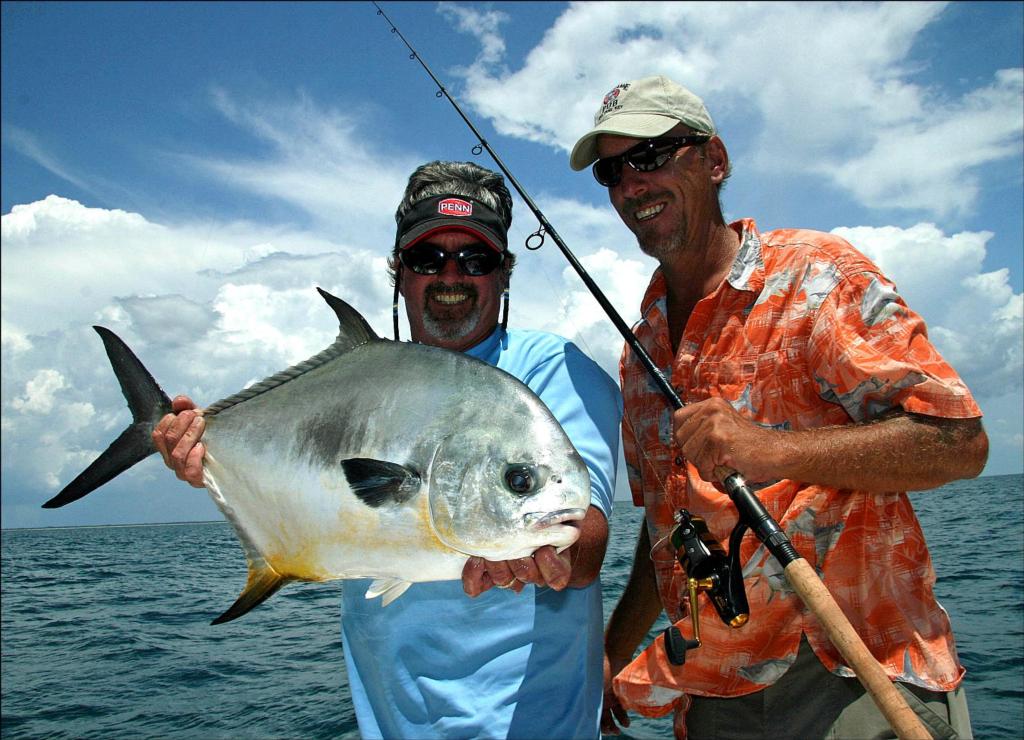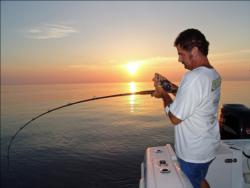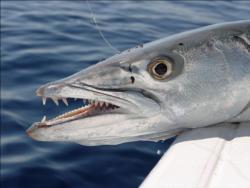Wreck rap
Nautical misfortunes yield fishing gold mines

Many things can wreck your summer: mosquitoes, thunderstorms, extreme heat, long lines at theme parks and other tourist sites. However, “wrecking” is not necessarily a bad thing – especially if you enjoy tugging on big fish.
From large ships to various shrimpers, barges, sailboats and aircraft, the Atlantic Ocean and Gulf of Mexico have amassed an eerie assemblage of wrecks. Fates range from weather to onboard fires to intentional scuttling by folks who didn’t want to get caught carrying what they were carrying. East Coast shoals have claimed many a vessel; in fact, the waters off North Carolina’s Outer Banks are known as the “Graveyard of the Atlantic.”
Stories vary greatly, but one common thread exists: Each of these submerged structures attracts a host of sport-fish species that will keep you busy for hours.
First, some perspective: Fishing is often a game of give and take, but where wrecks are concerned, it’s more of a take-and-give deal. We’re certainly not dismissing the tragedy of lost lives and property, but after years of fostering marine ecosystem growth, the structures honor their ill-fated crews with a requiem of recreational revelry.
From 20-foot depths within eyesight of the beach on out to 200-plus feet, wreck action can be fast and furious during summer’s often flat-calm conditions. Geography and depth governs specific selections, but a handful of predators comprise a fairly predictable cast of wreck denizens.
As in all angling scenarios, the key to successful wreck fishing is diversity and flexibility. Keep several outfits rigged and ready, keep your eyes open for targets of opportunity, and don’t hesitate to try multiple presentations until you determine what produces on a given day.
Here’s a rundown of common wreck targets:
 Amberjack: No sense mincing words, AJs are the thugs of the wreck. Huge appetites and brute strength make them a popular target, while thick, firm filets do very well on the grill or in the smoker.
Amberjack: No sense mincing words, AJs are the thugs of the wreck. Huge appetites and brute strength make them a popular target, while thick, firm filets do very well on the grill or in the smoker.
Six- to 8-ounce diamond jigs or lead-head jigs with white or chartreuse curl tails will tempt amberjack, but the direct path to a sore back and a full fish box is live bait. Blue runners, grunts and big pinfish are standard, but netting a load of pilchards, threadfin herring or menhaden inshore gives you an irresistible AJ treat.
If barracuda are thick, you may have trouble getting live bait through the toothy perimeter patrol. Remedy this by deploying livies on downriggers about 50 yards from the wreck and trolling them under the cuda radar.
Even small amberjack of 10 to 20 pounds will stretch your arms, but the jumbos reaching 50-plus will send you to a chiropractor. Fighting belts provide helpful leverage and keep the rod butt from bruising your abdomen area. Seasoned AJ tamers use their knee or the gunwale as a fulcrum so they can apply more downward pressure on the rod butt.
Snapper: There are better spots for mangrove and red snapper, but don’t overlook this option for tossing another dinner species in the box. Fish chunks of frozen sardines or squid on knocker rigs with small circle hooks is always a good bet. If the bite is slow to start, send a live pilchard or pinfish down to jump start the action. When you hook a snapper, crank like mad or risk losing your catch to marauding barracudas or hulking goliath grouper.
Kingfish: Despite the traditional explanation of how king mackerel migrate along the coasts, there’s usually a fairly dependable batch of summertime kingfish action over deep-water wrecks. Slow-trolling live blue runners, menhaden, pilchards or threadfin herring works fine, but downriggers often play a major role when kings focus on wreck-oriented forage. Sink a live blue runner on one downrigger, set a dead ribbonfish on the other, and stagger the baits above the wreck.
For some, kingfish merit only secondary focus on the wrecks. Nevertheless, why not capitalize on all opportunities? While anchored for other wreck species, free-line a live baitfish off the stern for any kingfish that may be patrolling the perimeter. This strategy may also attract tuna, dolphin or wahoo.
Permit: They’re mostly a central to southern Florida species, but permit merit inclusion on the wreck menu. Once a closely guarded secret, the big cousin of pompano is now a well-known delight that blends schooling aggression with spirited fights and delicious filets. Often seen “finning” at the surface, permit are suckers for a small blue crab or a pass crab fished on a No. 1 light wire hook set through the corner of the shell. Free-lining works best, but if the fish hang deep, add a small split shot or replace the hook with an 1/8-ounce jighead.
Much like tarpon, wreck permit can offer enough activity for multiple boats to work a spot, but it only takes one goober to screw it up for everyone. Avoid this by anchoring a respectful distance from anyone who beats you to a spot. Also, never idle across a wreck site looking for fish – especially with other vessels on-site – as this will put the fish down for longer than anyone wants to wait. Drifting is the best way to size up your spot, peak at who’s below and sight-cast without spooking these notoriously skittish fish.
 Cobia: The most consistent way to target wreck cobia is to target other species. Fact is, these flat-headed crab crunchers regularly grab live baits deployed for kingfish, intercept jigs dropped for amberjack and wander right up to the boat, apparently sniffing around for something edible. If the brown bombers show up, pitch a live pinfish or whitebait their way and it’s game on. Large plastic eels on half-ounce jigheads also work well for impromptu cobia casting.
Cobia: The most consistent way to target wreck cobia is to target other species. Fact is, these flat-headed crab crunchers regularly grab live baits deployed for kingfish, intercept jigs dropped for amberjack and wander right up to the boat, apparently sniffing around for something edible. If the brown bombers show up, pitch a live pinfish or whitebait their way and it’s game on. Large plastic eels on half-ounce jigheads also work well for impromptu cobia casting.
Barracuda: Largely considered a wreck nuisance given to slicing off hooked snapper or grabbing baits meant for kingfish, cudas actually deliver respectable fights marked with long runs and several leaps. It’s not hard to talk them into a live bait, but for an artificial option, use a “cuda lure.” Available in coastal bait shops, this slender baitfish imitator is easily made by running a piece of braided wire leader through an 8-inch section of red or chartreuse surgical tubing, affixing a No. 2 treble hook to one end and a swivel to the other. For longer casts, rig a 1/2-ounce egg singer between the hook and the bottom of the tubing.
Sea sense
 Sometimes, the wreck action fires up as soon as you drop the first bait. Other times, the locals need a little convincing. Experienced wreckers know that beating the surface with a rod tip will bring curious amberjack topside to investigate. For other species, the scent of potential meals holds a powerful attraction.
Sometimes, the wreck action fires up as soon as you drop the first bait. Other times, the locals need a little convincing. Experienced wreckers know that beating the surface with a rod tip will bring curious amberjack topside to investigate. For other species, the scent of potential meals holds a powerful attraction.
Handfuls of lively minnows tossed across the wreck area won’t go unnoticed. Expect amberjack, kingfish and cobia to find the freebies. Chopping fresh baitfish into nickel sized chunks and dropping them a few at a time creates a line of appetizers that will bring the snapper right to your transom. Complement the nuggets with a melting chum block and you’re likely to have a sight-casting dream of snapper, jacks, kingfish and cobia swimming around your boat.
A few more wreck tips
Gear up: Carry heavy-action boat rods and 4/0 class reels with 50- to 80-pound main line and 80- to 100-pound fluorocarbon leader for amberjack (rig a couple of these outfits with 30-pound line and 40-pound leaders for snapper). For pelagics (kingfish, tuna, wahoo), go with medium-action soft-tip rods and high-speed reels loaded with at least 300 yards of 30-pound line capped with 4 feet of No. 4 wire leader (substitute fluorocarbon leader if the fish are spooky). Medium-action spinning outfits with 30-pound braided line and 40-pound fluorocarbon leaders will handle most other wreck duties.
Spread out: Stagger your crew from bow to stern, as varying your presentations by a few yards can help you locate the sweet spots. This also minimizes tangling on multiple hookups.
Inspect the spot: Wooden vessels eventually deteriorate in saltwater, but even steel bodies may break apart depending on the cause of their demise and how they sink. Storms can also affect wreck sites by displacing all or part of a wreck. For these reasons, it’s often productive to snoop around a wreck site to find the most promising section.
 With multiple pieces, fish one area and move to another when the action diminishes. If the pieces lie in close proximity, positioning between them may allow you to bottom fish both structures, while also targeting permit, cobia and others that work back and forth.
With multiple pieces, fish one area and move to another when the action diminishes. If the pieces lie in close proximity, positioning between them may allow you to bottom fish both structures, while also targeting permit, cobia and others that work back and forth.
Keep an eye to the skies: Summer means thunderstorms, so check the day’s forecast and watch the horizon for building trouble spots. Offshore storms are typically isolated, so plan your day with several wreck-site targets that will enable you to dodge the rough weather and keep on fishing.